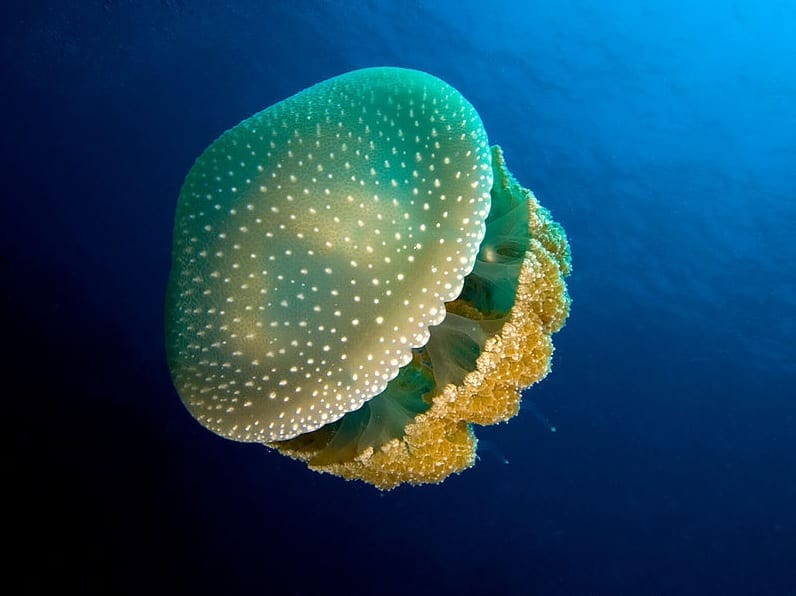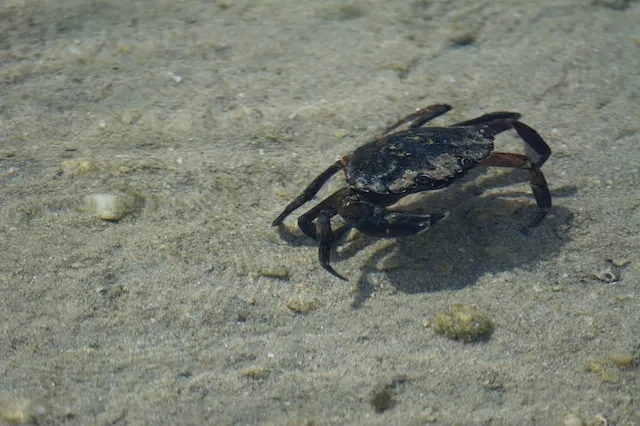The foundations of the food chain
The ocean is home to a diverse range of species from microscopic plankton, to large marine vertebrates. All species play a key role in regulating the marine food chain, but plankton form the basis of the marine food chain and are responsible for much of the air that we breathe and the food that we eat. There are two types of plankton – phytoplankton and zooplankton, both of which drift on ocean currents.
Phytoplankton: Microscopic Ocean Powerhouses
Phytoplankton are microscopic organisms that live in the ocean and freshwater. These tiny organisms can be single-celled plants, bacteria, or protists. Just like terrestrial plants, phytoplankton photosynthesize, turning sunlight into energy.
During this process, carbon dioxide is consumed and oxygen is produced as a byproduct. Due to needing sunlight for photosynthesis, phytoplankton floats near the water’s surface.
Zooplankton: Tiny but Vital Consumers
Zooplankton are animals that can be tiny like phytoplankton, or much larger in size. Zooplankton consists of jellyfish, krill, sea snails, pelagic worms, invertebrates and fish to name a few. Most zooplankton will feed on phytoplankton, which in turn are eaten by larger animals, or by other zooplankton.
To avoid predators, zooplankton will remain at depth during daylight hours, drifting to the surface at night to feed. This vertical migration is widely considered as the largest migration on earth.

Predator-Prey Relationships
Predator-prey relationships occur when one species (the predator) hunts and consumes another species (the prey) for food. These relationships influence animal behaviour and shape ecosystems. Predator-prey relationships are not only key to regulate prey populations but prey availability also influences predator numbers.
Through evolutionary history, both sides of the relationship will adapt with predators becoming faster, and prey becoming better camouflaged or improving escape tactics.
Top Ocean Predators
Top ocean predators, also known as apex predators, regulate the marine food chain through top-down control of prey. Top ocean predators often have a wide range and can act as “sentinels” of an ecosystem’s response to change, providing information on otherwise unobserved change.
Top ocean predators often exhibit behavioural or physical adaptations that make them excellent predators. For example, killer whales will work together using tactical hunting strategies to effectively catch prey. The biology of the great white shark, with a streamline body for speed and powerful jaws allows them to exploit a wide range of prey and habitats.

Smaller Prey and Their Adaptations
Over time, many prey have adapted to living in a particular habitat and avoiding predators. These adaptive traits become common in a population through natural selection, with individuals showing these traits being more likely to survive and reproduce.
These adaptations can be morphological (things you can see such as body shape), physiological (an organism’s metabolism, body function etc.), or behavioural (learned or inherited). For example, pufferfish have spines all over their body (morphological), poisons in the skin (physiological), and inflates its body (behavioural) to deter predators.
Complexity of the Food Web
The ocean food chain is not actually a chain, but rather an interconnected web which is divided into different trophic levels. The first level starts with the primary producer/autotroph which are organisms such as algae and phytoplankton that produce food.
The second level is the primary consumer/heterotroph, an animal that eats the primary producer such as shrimp, copepods, oysters etc. Then there is the secondary consumer which eats the primary consumer such as sea stars, crabs, lobsters etc.

The tertiary consumer eats the secondary consumer, and the apex predator is at the top of the chain with no predators. The final level of the food chain is the decomposer/detritivore that breaks down dead animal and plant matter before releasing it back into the system as energy and nutrients. Examples of decomposers are bacteria, fungi, and worms.
Symbiotic Relationships
Symbiotic relationships are evolved interactions or close living relationships between individuals of different species, where one or both benefit. Such relationships are classified as either commensalism, mutualism, or parasitism.
Commensalism is where one species benefits, and the other is unharmed. Commensalism is seen between barnacles and whales. Barnacles attach to the whale’s skin and benefit from being shielded from predators and allowing barnacles to move through the water easily. In this relationship, the whale is not directly affected by the barnacle’s attachment.

Mutualism is where both species benefit such as in the well known example of the clownfish and sea anemone. Clownfish are immune to the sting of anemones, meaning they can use the anemone as a safe place to lay and tend to their eggs. In return, the clownfish keeps the anemone free of parasites and provides nutrients through their faeces.
Parasitism is where one species benefits to the detriment of the other such as with fish and sea lampreys. In their adult stage, sea lampreys will attach and suck the bodily fluids of their host fish. In this relationship, the sea lampreys benefit at the expense of the host fish.
Disruptions and Threats
Plankton are sensitive to changes in salinity, temperature, and nutrient concentration in the marine environment. When there is a high nutrient concentration algal blooms may result, where there is excessive growth of algae.
This change in nutrient concentration can be due to pollution runoff from fertiliser and agriculture, effluent from sewage treatment works, and dissolved chemicals from rainfall or irrigation. Hypoxia may occur as a result of algal blooms and cause an imbalance in the marine food chain. Though it is important to note that not all algal blooms are harmful and they can be used as indicators of marine and terrestrial environmental change.
Seasonal Changes and Imbalances
Phytoplankton growth varies seasonally with differing amounts of sunlight. In high latitudes, storms in winter cause mixing of water bringing nutrients to the surface from depth, resulting in an explosion of spring phytoplankton growth.
However, in subtropical oceans summer sees a reduction in phytoplankton productivity with a lack of warm and cold water mixing. In low latitudes phytoplankton blooms are often linked to monsoon-related changes in wind. As the wind alternates between onshore and offshore, it will increase or suppress nutrient upwelling causing seasonal change in phytoplankton productivity.
Ocean Acidification’s Impacts
Ocean acidification from anthropogenic carbon dioxide alters marine chemistry, with potential consequences for different levels in the marine food chain. Given the speed at which the acidity of the ocean has been changing, many marine species have not had sufficient time to adapt or migrate. Ocean acidification causes decreased carbonate availability and increased acidity.
Decreased carbonate availability can harm species reliant on carbonate-based shells or skeletons such as oysters and mussels. Increased acidity can cause harm to species sensitive to acidity and also species higher up the food chain feeding on these sensitive organisms. However, much is still unknown about how the marine ecosystem will be impacted by ocean acidification.
Adapting to Change
Species are adapted to a specific set of environmental conditions, and any changes in salinity, water clarity, or nutrient content can change the species present in that area. As ocean temperature increases, water has become increasingly stratified with less vertical mixing of nutrients.
This can negatively impact larger phytoplankton which need more nutrients and rely upon water mixing and nutrient cycling.
Protecting the Ocean Food Chain
Annual phytoplankton productivity is linked to the El Niño Southern Oscillation climate pattern. This causes change in wind patterns, sea surface temperatures and rainfall along the equator in the Pacific Ocean.
El Niño events are far reaching, with any changes in phytoplankton productivity potentially having significant impacts on biodiversity, food supply, and the pace of global warming.
Conclusion
The marine food chain is extensive, with a diverse range of species that make up complex predator-prey relationships. Phytoplankton, algae, and bacteria form the basis of the marine food chain as primary producers. Consumers feed on the producers, and decomposers are decaying biological matter that return nutrients to the ecosystem.
The marine food chain is a web of interactions that can be dramatically affected by threats such as climate change, overfishing and marine pollution. It is important that the marine food chain is kept in ecological balance, to prevent cascading effects through trophic levels.


